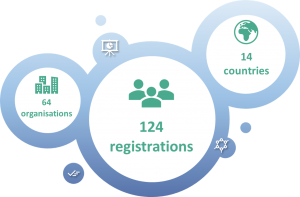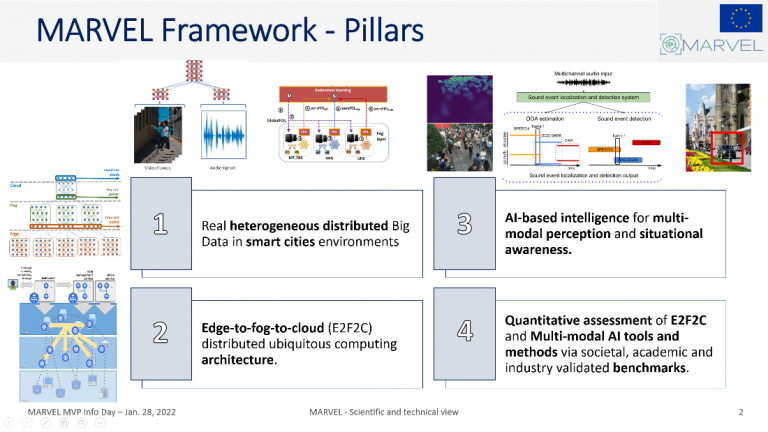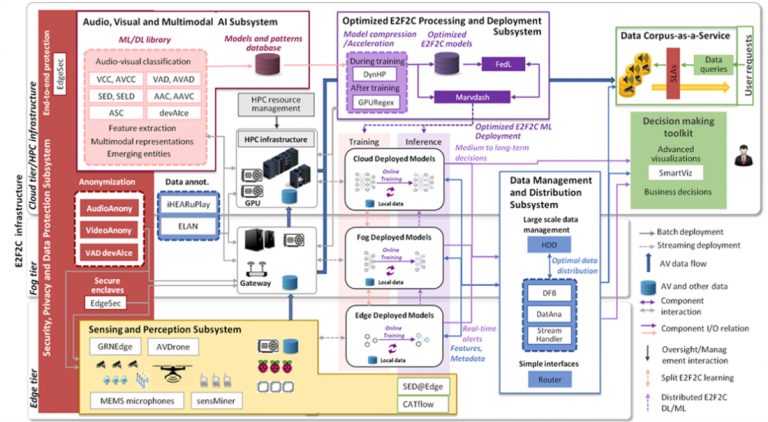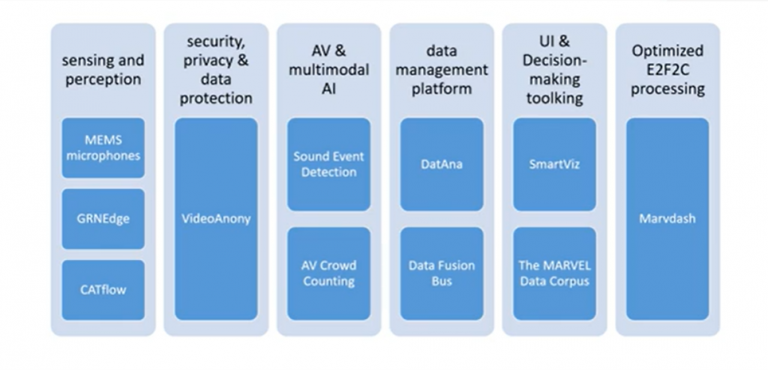MARVEL MVP Info Day - Insights & Lessons Learned
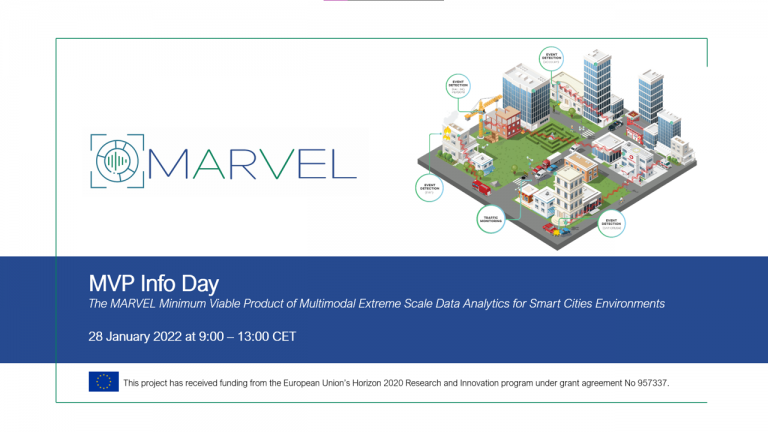
The 1st MARVEL MVP Info Day was successfully held on January 28th, 2022, virtually hosted by Fondazione Bruno Kessler. There were 96 attendees coming from Municipalities, and the industry, as well as academic experts in the field of ICT solutions for smart cities, professionals from innovation hubs, and a local network of enterprise representatives interested in leveraging AI solutions for multimodal big data analytics in their businesses. More specifically 60.47% of the participants were from research and academia, 7% from PAs, 9.3% were smart city service providers, 14% were project partners or relevant stakeholders in H2020, and the rest equally divided between governmental agencies, Big Data/IoT/AI-relevant association, and general public. During the event, several related poll questions were launched to collect the feeling of the audience about the technologies presented and feedback on the project motivation, strong and weak points, and possible future directions.
MARVEL MVP Info Day objectives
- Raise awareness about the H2020 EU-funded MARVEL project.
- Present the MARVEL Minimum Viable Product related to the Malta smart city test cases.
- Collect feedback from smart city decision-makers, i.e., Public Administrations (PAs), law enforcement agencies, and industry specialists, on the MARVEL framework and the proposed technical approach. This feedback will contribute to shaping future steps within the project.
- Enlarge the community with an active interest in the project.
- Explore opportunities for continuous collaboration between the project and the relevant stakeholder (industries, PAs, governmental agencies such as law enforcement, traffic managers, etc.) in the area.
Agenda overview
The event started with a welcome session by the Digital Society Director of FBK, Dr. Marco Pistore, who presented how the strategy of FBK is in line with the aim pursued by MARVEL. Mr. Giacomo Fioroni, head of the Smart City project of the Municipality of Trento followed with a presentation tackling the question “Why is MARVEL relevant to the city of Trento?” as an example of why the idea behind MARVEL can be applied in other smart cities in Europe. Prof. Sotiris Ioannidis (FORTH), the Project Coordinator of MARVEL, provided an overview of the project, highlighting the motivation, vision and objectives of MARVEL. Prof. Dragana Bajovic (UNS), MARVEL Scientific & Technical Coordinator, followed with the scientific and technical presentation of MARVEL highlighting the MARVEL architecture and the main pillars of the project.
After this introductory part of the project, the workshop focused more on the experimental real-life use cases from the two smart cities. Mr. Thomas Festi (MT) and Dr. Yiming Wang (FBK) presented the defined test cases for the smart city of Trento while Prof. Adrian Muscat (GRN) presented the respective test cases for the smart city of Malta. Finally, the demonstration of the MARVEL Minimum Viable Product took place which was the main topic of the day by Dr. Christos Dimou (ITML) and Ms. Stella Markopoulou (ZELUS). The workshop concluded with a brainstorming and discussion session.
During the Info Day, the participants had the opportunity to exchange ideas and provide feedback, as previously mentioned, by answering a series of poll questions. The questions spanned from investigating the audience’s interest in MARVEL technologies and their application for the citizen quality of life improvement, which aspects were considered most innovative or relevant for smart cities, up to the identification of the main barriers or risks perceived and preventing their use in the attendees’ organizations, and in general of the aspects recognized as most challenging for the project.
Why should a city use MARVEL?
Marco Pistore, Giacomo Fioroni and Prof. Sotiris Ioannidis presented the motivation to undertake a project like MARVEL from the perspective of research and the impact on society. Cities have become actual “data engines” with a huge variety of IoT urban sensors and devices, recording multiple everyday activities and producing large-scale heterogeneous datasets. There is an evident need to extract valuable knowledge from these datasets for the benefit of decision-makers and the advantage of technology-makers that can do better research and business. The example of the Municipality of Trento well articulates the needs a city may have to find novel technologies able to leverage the value of the big data collected by distributed smart city sensors. Figure 2 depicts a screenshot from Giacomo Fioroni’s presentation, outlining the need for technologies able to extract, possibly in real-time, useful information for decision-makers from the data coming from multiple heterogeneous sensors spread in the city of Trento.
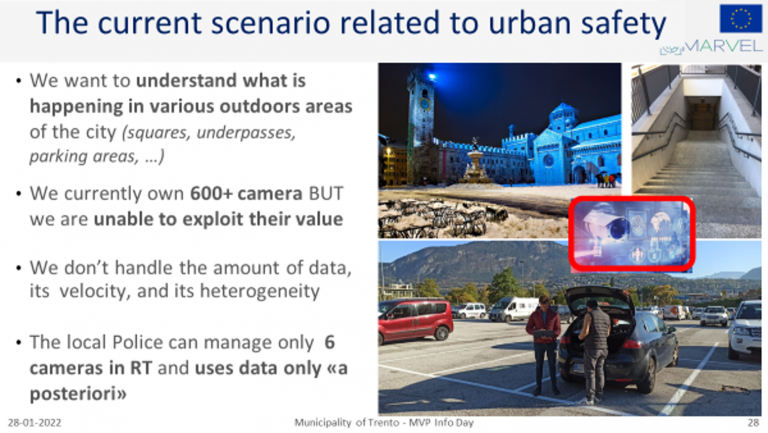
What is the audience's opinion about MARVEL?
Poll questions were launched to collect first-impression feedback on the motivations and needs that pushed the technological solutions proposed in MARVEL. The project received very encouraging feedback regarding its potential to improve citizens’ well-being in a smart city (>82% of positive answers). This also emerged later from the replies received from the polls during the presentation of the pilot test cases, i.e., 76% of the participants considered that the pilot in Trento can improve citizens’ well-being, security, and safety; similarly, 83% evaluated that the roads test case, addressed in Malta, will help with data-driven decisions and consequently improve citizens’ life.
MARVEL technology
Prof. Dragana Bajovic described in detail the MARVEL architecture and all technological components constituting the MARVEL framework as well as the innovative aspects present in the research the consortium is pursuing (see Figures 3 and 4). At the end of her presentation, the audience provided feedback on the most innovative aspects identified in the architecture. The preferences were equally distributed between the audio-visual AI components with synchronous processing of audio-visual streams, the E2F2C continuum processing and optimized deployment, the audio and video anonymization at the edge and the MARVEL Data Corpus-as-a-Service. Similarly, we asked which of these technologies were perceived as most relevant for big data applications in smart cities with a similar balance. There is anyway a slight prevalence towards AI technologies for processing multimodal streams and their anonymization at the edge (see results of Q5 and Q6 below)
The audience was also invited to express their views on the challenges that MARVEL may face. In this open question, many respondents mentioned privacy as the main challenge but also similar concepts such as anonymization, safety, and security. Other challenges identified were data availability, big data management in real-time, data labeling, bias in data, integration of components and operations in the framework, process optimization, analytics but also energy-efficiency, functionalities, and privacy in the different layers.
Results of Q5: What are in your view the most innovative aspects of the MARVEL architecture?
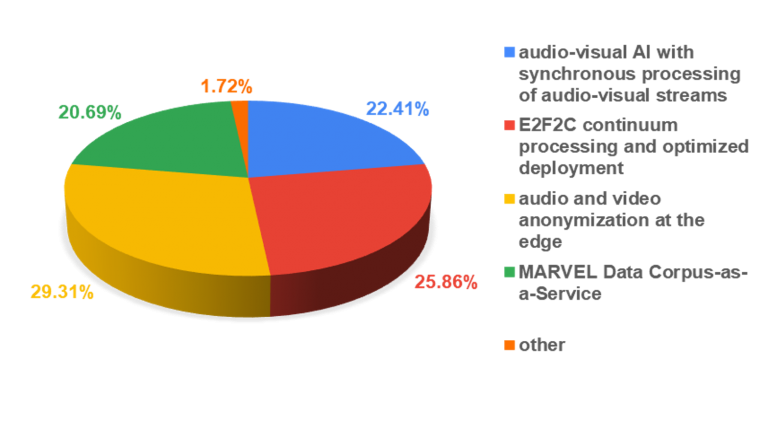
Results of Q6 : Which of the previous are in your view the most relevant for Big Data applications in smart cities?
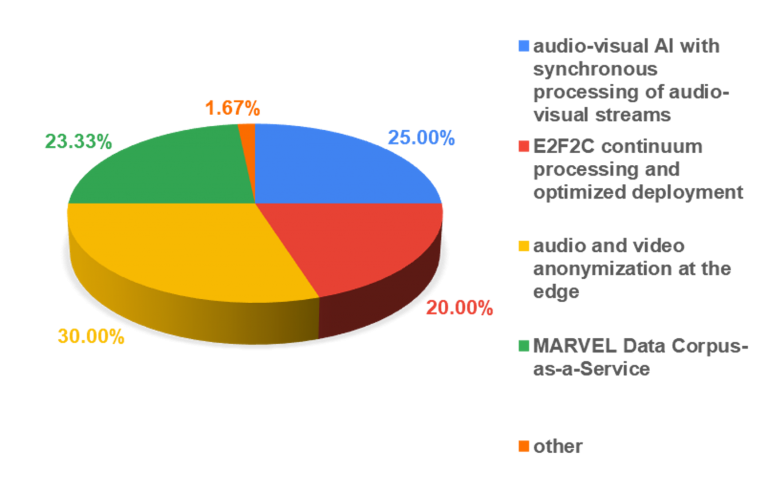
Privacy concerns
Privacy is a clear aspect that emerged in several questions and poll answers, i.e., the concern for citizens’ privacy and ethics, although MARVEL addresses this point very seriously both from the technology and legal point of view. Privacy is considered a challenge for several reasons; organizations may be reluctant to share data, as well as it may be very difficult to convince authorities or citizens that their privacy is respected. The consequence is often that major challenges arise in offering open data to the scientific and industrial community to grow their knowledge on several urban phenomena and related technology and business.
The workshop continued with presentations by the Municipality of Trento and Greenroads on the provided technology and the work accomplished so far to implement the defined test cases in Trento and Malta respectively. Additional ideas for both cities and test cases were requested from the audience. The responses revealed that for Trento, many participants highlighted the need for smart parking and public transport management, while for Malta the focus was more on technologies for traffic management and awareness/monitoring.
The importance of having information available about activity on roads and open spaces in day-to-day life was considered “extremely important” by approximately 45% of attendees, while 41% considered it “somewhat important” and the rest remained neutral. Nevertheless, services related to green mobility (car/bike-sharing, public transport improvements), car parking and traffic are perceived as important in a smart city. Moreover, several suggestions for additional smart city services that can potentially be addressed in MARVEL were related to sustainable mobility and mobility in general.
The MARVEL project Minimum Viable Product (MVP)
Dr. Christos Dimou (ITML) and Ms. Stella Markopoulou (ZELUS) presented the MARVEL Minimum Viable Product. Dr. Dimou started with the time plan for the realization of the MARVEL framework. The MVP was released in December 2021 (M12). The first complete prototype will be ready in June 2022 (M18), while the final prototype will be ready 1 year after, in June 2023 (M30). But why “Minimum”? Because on the first release date there was a minimum but enough set of functionalities that were successively demonstrated by Ms. Markopoulou through a demo. The aim to present MVP at the Info Day was to receive feedback at a very early stage of the development cycle of the MARVEL framework to detect shortcomings and obstacles and to have sufficient time to correct the path. The use case selected for the MVP was the GRN use case “Junction Traffic Trajectory”, which focuses on the analysis of long-term data to extract road users’ behavior (both vehicles and pedestrians) and also gather traffic statistics in road network junctions monitored by street-level cameras. This use case exploits a combination of MARVEL components and functionalities (e.g., vehicle identification and tracking, sound event and crowd counting) as shown in the figure below (Figure 5).
During the MVP demonstration, it was explained how these technologies could be used by smart cities for decision-making regarding traffic, urban roads, etc. This is achieved through the availability of relevant statistics followed by navigation and filtering options, as well as details about the presence of vehicles and pedestrians and their behavior in a specific road junction of interest. The information can be downloaded or displayed with easy-to-understand plots and graphs.
Similarly to the previous sessions, poll questions were launched and the feedback collected was very encouraging. Participants felt that the tool presented was easy to use and learn. Through an open question, we also collected some desired additional functionalities to consider for the next releases of the MARVEL framework such as crowdsourcing, the inclusion of more sensors, a forum for interaction, automated processing, real-data flows, real-time analytics and alerts, federated learning, analysis of preferred path based on the category of the vehicle, etc.
Overall, the feedback collected was very useful for the MARVEL consortium to better shape the next steps and achieve the next release by integrating the suggestions received during this Info Day.
Menu
- Home
- About
- Experimentation
- Knowledge Hub
- ContactResults
- News & Events
- Contact
Funding

This project has received funding from the European Union’s Horizon 2020 Research and Innovation program under grant agreement No 957337. The website reflects only the view of the author(s) and the Commission is not responsible for any use that may be made of the information it contains.

